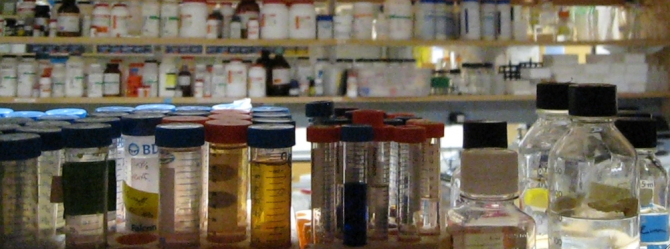20.109(S08):Site-directed mutagenesis (Day2)
Contents
Introduction
Last time you navigated a great deal of information in order to design mutagenized inverse pericams – nice work! Today you will put your designs into practice.
As you already know, the mutagenesis strategy you will use is based on PCR. You will begin by combing plasmid DNA encoding wild-type inverse pericam with the mutagenic primers you designed. These will be acted upon by a DNA polymerase to generate a mutant plasmid – at this stage the plasmid will be nicked, and won’t become whole until it is transformed into competent bacteria and repaired by them. In order to propagate only the mutant plasmid, the parental DNA is specifically digested using the DpnI enzyme. The thermocycling reaction will run for about two hours, and the digestion step for another hour. During these incubation times, we will discuss two articles from the primary literature.
We will ‘warm-up’ by discussing the paper by Heim, Prasher, and Tsien. This is a short paper describing the very first attempt to mutagenize GFP, and a fine introduction to some of the concepts and methods used in this module. Next we will do a close reading of the paper that introduced inverse pericam, by Nagai et al.
Protocols
Part 1: primer preparation
- Calculate the amount of water needed for each primer to give a concentration of 1 ng/mL.
- Touch-spin your primers, resuspend each in the appropriate volume of water, and touch-spin again.
- Calculate the dilution of primer that you need to prepare in order to have 125 ng present in 2.5 μL. Prepare 100-200 μL of this dilution and keep it on ice.
Part 2: site-directed mutagenesis
We will be using the QuickChange® kit from Stratagene to perform our site-directed mutageneses. Each group will set up two reactions. Meanwhile, your TA will set up a single positive control reaction, to ensure that all the reagents are working properly. You should work quickly but carefully, and keep your tubes in a chilled container at all times.
- Read through the following protocol and prepare all calculations before beginning physical manipulations of your samples.
- You will be given an X μL mixture that contains buffer and dNTPs when you are ready to begin. Aliquot 40 μL per tube.
- Add 2 μL of template DNA (“IPC plasmid”) to each of your two reaction tubes.
- Note: mutagenesis reactions are expected to run smoothly with 5-50 ng of plasmid DNA. You have been given a 1:200 dilution of miniprep DNA.
- Increase the volume of each reaction to 50 μL by adding the appropriate amount of water.
- Finally, add 1 μL of PfuTurbo DNA polymerase to each reaction.
- Once each group is ready, we will begin the thermocycler, under the following conditions:
| Segment | Cycles | Temperature (° C) | Time |
|---|---|---|---|
| 1 | 1 | 95 | 30 sec |
| 2 | 18 | 95 | 30 sec |
| 55 | 1 min | ||
| 68 | 5 min | ||
| 3 | 1 | 4 | indefinite |
- After the cycling is completed, each group should add 1 μL of DpnI per tube. Samples will be incubated for one hour at 37 ° C. You will be asked to how this enzyme works in your homework assignments.
- This final incubation step will take us past lab closing time, at which point the teaching staff will take over. Each reaction will be transformed into XL1-Blue competent cells under delicate conditions. (*define procedure in note below).
- Tomorrow, two candidate colonies will be chosen from each plate. The efficiency of this mutagenesis protocol is reported to be 80%. We will sequence two candidates per mutation to cover our bases, so to speak.
Part 3: Prepare tubes for liquid O/N cultures
You will make your teaching faculty very happy if you contribute to their preparatory work. Please label 4 large glass test tubes with your team color and sample name. Mix 12 ml LB with 12 μL each of ampicillin and chloramphenicol. Aliquot 2.5 mL of LB+Amp/Cam per tube. These will be used to set up overnight cultures for you for next time.
Part 4: journal article discussion
During the production of the mutagenized DNA, we will discuss the two journal articles cited in the introduction. The purpose of this discussion will be two-fold: 1) to familiarize ourselves with the history of protein design, and 2) to explore ways of talking about the scientific literature.
As you read the paper by Heim, Prasher, and Tsien, consider the following questions.
- What are the advantages of GFP compared to synthetic fluorescent dyes, and what are its limitations? Which of these limitations are Heim et al. trying to address?
- What methods did the authors use for mutagenesis, and how do they compare to the method we are using?
- How were mutagenic proteins initially selected, and how were the chosen ones further analyzed?
- What is the significance of the different wild-type protein fractions shown in Figure 1?
- If GFP maturation does not require any cofactors for a chemical reaction, why does it take four hours? What lines of evidence suggest the absence of cofactors?
- In what part(s) of the protein were useful amino acid substitutions found?
